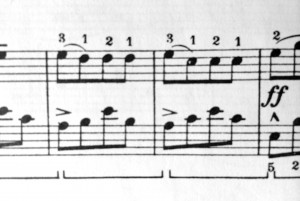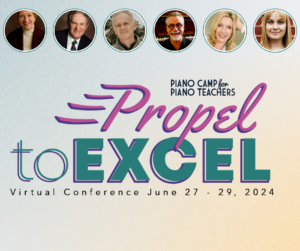I’ve decided to take a different approach to my reaction posts in an effort to get right to the point and make it easier for readers to get the essentials. I’m writing with the assumption that you have played through the pieces and that you might have your score in hand, but even if not, a casual reader will hopefully walk away with some food for thought after viewing the YouTube videos included. Let me know what you think of the new format.
Quick scan thoughts:
- I like the fact that the first 10 in Vol. 1 exhibit a variety of tempos and key areas – a little something for every student’s taste and need. I would classify Nos. 6 thru 9 as late elementary in level and No. 10 as early intermediate due to the quick tempo, coordination of the hands, and the detailed articulation, especially the opposing articulation between the hands.
- Simple key areas are still used, including the Aeolian mode (natural minor) and both hands are still generally one octave apart. Melodies appear in the RH.
- Bartok continues his precise dynamic and articulation markings. I notice more tempo changes within a piece and a more percussive nature in three of the pieces.
- Bartok seems to enjoy the writing variations of a single theme as the basis for his forms. You don’t see this often in easier classics. Very unique.
- All the pieces are less than a minute in length, except for no. 8 and 9. He doesn’t provide a timing for No. 9, but it would appear that it would extend longer than 60 seconds.
No. 6 – Study for the Left Hand
The Expressive Idea: Given the title, I would say this is a study in LH ostinato at a fast tempo and at various dynamic levels. Do you notice how Bartok starts the piece the forte (molto marcato) and gradually diminishes the volume with each repeat of the melody? Excellent etude in dynamic control.
Willard Palmer titled this “Folk Dance” in his collection “Bela Bartok: Introduction to his Piano Works.” Here is the translation of the lyric that was sung to this old Hungarian melody:
Flowers tell my love for you.
Tulips, red carnations too,
Larkspur and this scarlet sage tell my burning love for you.
Who would have guessed this melody was originally a love song?
Technical Challenges: – Rhythmic steadiness in the LH while keeping the sound sharp and clear. No slumping pinkies here! Keep the hand rounded and with firm fingertips. To maintain the detached effect in the LH eighths, I would recommend a quick forearm staccato using the elbow as the hinge.
Excellent piece for teaching alternating-finger staccato (see m. 5). I highly recommend alternating fingers for the best clarity in staccato. It’s not too difficult for young students to learn. In fact, they often find it fascinating.
I suggest the following fingering changes for students with smaller hands or shorter fingers:

Mm. 36-38 (also notice my LH accents here to help students create pulses for rhythmic steadiness, but don’t over-emphasize)
ALSO…..In MM. 42 and 48 – try 1 and 5 in the LH instead
Recommended For: Students who love those primal-sounding pieces and who want something fast and exciting. This work could replace that supposed “Native American” piece to which students of today are still quite attracted. Great for those who need work in steadiness.
Correlates To: Late 2B to Early 3A of Faber Piano Adventures. Keep the LH forearm staccato technique in mind, plus the RH alternating finger staccato and fast-changing articulations.
https://www.youtube.com/watch?v=PII2sIkEIFs
No. 7 – Play Song (also seen as “Sewing Song”)
The Expressive Idea: This is the sound of quiet play, as when a child is playing alone quite peacefully and chanting to himself/herself. Notice the use of falling 3rds and 2nds which are so typical in children’s songs.
Again in Mr. Palmer’s “Bela Bartok: Introduction to his Piano Works, ” he provided the the translation of the song that was sung to this melody. It was all about a mother mending a child’s shirt! (hence, his title of “Sewing Song”)
Technical Challenges: Playing an expressive, singing melody is definitely in order. It’s one of the first things I would ask the student to learn well and completely separate from the accompaniment. Notice Bartok’s change of fingering in the RH of m. 1 to imply separating the tenuto note from the slurred notes. He really desired a change of inflection here (2 separate ideas: a single sound followed by a legato phrase). The LH is quiet, filled with legato double notes and chords.
Please consider the student’s reach especially in areas like these:

Notice how Bartok occasionally cues the performer to use the pedal to achieve the legato in the 2-note slurs — mm. 5-6, and similar areas.
Here’s a fingering change I would recommend. His is quite a stretch!

Recommended For: Students who love a beautiful melody or a student who needs work in “cantabile” playing and may not desire a long piece. The intermittent pedaling wouldn’t be difficult to achieve.
Correlates To: Faber mid-to-late 2B to Early 3A, but keep in mind the LH stretches and LH legato technique required.
https://www.youtube.com/watch?v=pyamHbyMjYA
No. 8 – Children’s Game
The Expressive Idea: This piece evokes images of children running outdoors and playing games like tag, circle games, and so forth. Ask students to describe the children’s activities and antics while you demonstrate the various sections. This really brings it to life for them.
Again in “Bela Bartok: Introduction to his Piano Works, ” Palmer provided the the translation of the song that was sung to this melody. It was all about a mother mending a child’s shirt!
Technical Challenges:
1. Much of the focus here is on the coordination between hands which work opposite of each other in articulation, rhythm, or both. Here’s such an area where the player really needs to focus on releasing RH slurs while the LH remains legato:

Mm. 13- 16
2. The tempo changes need to be planned and executed carefully.
Tricky Section Alert! Isolate this LH 2-note slur section immediately at lesson one so a student may get it immediately into “automatic” mode, as I often call it. Truly drop the wrist and execute a forward lift on the 5th finger.

Mm. 62 – 68
Recommended For: Students who are intrigued by a story-telling piece or a “character” piece, or who might need such a piece to motivate them. The rhythmic flair is appealing, too. Try to demonstrate this well to students and tell your own version of the story while doing so. I did this recently and the student just lit up!
Correlates To: Faber mid-late 2B to early 3A, but keep in mind the LH reaches. Prior experience in a multiplicity of short slurs is a must! And they must be willing to go after that tricky LH part (mm. 62 – 68).
https://www.youtube.com/watch?v=YoIUC6Okslw
No. 9 – Song
The Expressive Idea: This is not a commonly-played piece in the “For Children” Volume One. It’s brief, yet long on expression, especially due to the long notes on the cadences. I hear two moods associated with the contrasting sections (the Adagio vs. the Poco piu vivo). In pieces such as this, I ask students to describe what the child might be singing about while I demonstrate (EX: something sad or troublesome in the slow section vs. the spark in the faster sections – perhaps a happy memory of a playful time?). I think students really enjoy character changes within a piece, especially if they can picture it in their minds.
Technical Challenges:
1. There are not many notes in this piece, but good control is required for the sound effects Bartok outlines quite clearly. EX: The decay of the long notes in the cadences.
2. He is precise about the differences in tempo between the sections. For the Poco piu vivo, the student needs to be absolute about the length given to the changing note values and observant of the tapering wrist lifts at the ends of phrases.
Tricky Section Alert! LH MM. 9-11 and 23-25: For those with small hands, the LH requires some contortion! To connect these particular chords, apply the pedal between them.
Recommended For: An older child or adult, in my opinion. An effective expression for this piece would require some maturity and good sense of timing. However….a pensive performance could be taught to any sensitive and willing student.
Correlates To: Faber 2B or later.
https://www.youtube.com/watch?v=zOOh4pEFz3w
*The tempo in the poco piu vivo not quite animated enough for the contrast.
No. 10 – Children’s Dance
The Expressive Idea: Images of many children playing on a playground come to mind. Lots of whirling and twirling in the hands creating a rich, propelling sound. Bartok refers to it as “impetuoso” in m. 5 (full of sudden or rash actions). I like how the sounds reach a full din, subside some, and then start up again. Just like kids, right? Bartok knew what he was doing.
Technical Challenges: I have an adult student working on this piece currently and here are some of her conclusions made during her early stage of learning this piece, in mostly her words:
1. Become aware of the LH chordal shapes by blocking them measure by measure and then playing them blocked while RH plays as written.
In mm. 13-14, this is the first time that the RH breaks off from the usual pattern:
 Take these 2 measures apart to to learn what is happening in each hand. (Me: notice the other “impetuous” shifts Bartok inserts later also)
Take these 2 measures apart to to learn what is happening in each hand. (Me: notice the other “impetuous” shifts Bartok inserts later also)
2. Learn the 4mm. phrases individually by isolating each and practicing them for fluency. Then start combining them.
Recommended For: A student who has already had some experience with simultaneous movement in both hands and opposing articulations. A good sense of rhythmic steadiness would also help. This is an unrelenting mini-toccata.
https://www.youtube.com/watch?v=A2JLfe011Dk
*A little on the slow side.
Correlates To: Faber 3B or later due to the fast finger work and it’s especially intricate articulation.
A vastly different set of 5 than before. Which do you like? I played Nos. 6 and 8 as a child and recall liking them very much. I’ve taught Nos. 7, 8, and 10. One of my adult students really enjoyed No. 7 and she’s currently gnashing her teeth over No. 10, but she’s determined!































